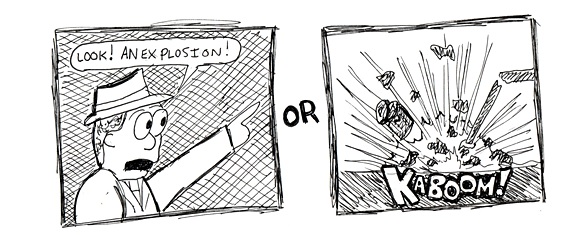Possibly one of the hardest things you’ll ever do in comic creation is writing dialogue. It’s one thing to set a scene and drop characters into it, but it’s another thing to give each character their own unique voice and do it in such a way that sounds natural and not forced. OMG RLY? (Rule #1: NEVER use TXT speak in dialogue. Show some intelligence and s p e l l o u t the words people.) In this article, I will be going over the basics on how to write dialogue for your comic as well as a recipe for great lentil soup. (connect every other letter and you’ll find it….maybe.)
ABOUT DIALOGUE IN COMICS
Writing dialogue is sometimes more of an art than a science. Not only does the dialogue have to sound realistic, but it also has to match the character you’re writing for. Having a distinguished scientist talk like he and his hommies are going to have a 40 on the street corner will probably ruin the credibility you’re looking for in that character. This is why it’s important to work out character bios before you start writing your script. They help capture the flavor of the character so you know exactly what words they’ll say when the time comes.
SOUND IT OUT
Once you write the dialogue for the character, you need to make sure it sounds realistic. I can’t offer any better advice than to speak the dialogue out loud. Listen to how you say it, did it sound corny? Did it sound long winded? Did it sound like Luke Skywalker whining about wanting to go to the Tosche Station to pick up some power converters? Maybe you noticed that when you spoke you said the same thing differently, changing a word here or there. Often times reading it out loud will reveal exactly how strong the dialogue is, or isn’t, giving you the chance to make adjustments as needed.
And word of warning, when speaking the dialogue out loud, don’t do it in a public place, especially if your comic is about homicidal clowns wanting to seek revenge for some unjust crime. People will stare at you. Trust me.
WRITE DIALOGUE AS AN ACTOR
You have to put your acting hat on and remember to write differently for each character based on their mood or general disposition. If someone is panicky all the time, they may talk in short fragmented sentences. If someone is well educated, they may use elaborate words and talk on and on about stuff the other characters think is boring. Do they have an accent? Ya nee’ta write wha’tha sounds like. Not only are you the writer, but you are the actor giving these characters a voice!
REMEMBER THE MEDIUM
Remember that you are writing for a comic, which is a visual medium. There’s always a fine line with comics in deciding if the dialogue moves the story forward or if the visuals do. Would you rather have someone say what is happening in your panel, or just show the reader what is happening?
Remember a picture is worth a thousand words, and in comics it’s even more important!

THE FINE ART OF LESS IS MORE
I find comic writing incredibly challenging at times since I don’t know if what I write will fit until I start creating the artwork. I’ll have this great bit of dialogue, but when I place it in the comic panel I realize I have zero room for half of it. I then have to edit it down a few times to make it fit. In some cases I can’t edit it down, so I’ll split the dialogue into the next panel, which then pushes the rest of the script back, causing me to edit something else further down the line. It’s like trying to hammer the round peg through the square hole, and my head is the hammer!
The flip side to this is that there are also times where I’ve written something for a specific panel and ended up having room to spare, so I would expand on the words to fill the panel better.
Just keep in mind that you will more than likely have to tweak your dialogue when it goes from script to being placed on the panel. If you’re working with an artist, you need to figure out how to address each problem together. What is really vital that has to stay? What can be cut down or moved somewhere else? Don’t take it personally if your artist requests changes as sometimes that’s the only way to get things to fit!
Of course you can let the visuals tell the story and have the dialogue be secondary. There have been some great comics out there who have done this. Pages of just art to tell the story with no dialogue. I’ve also read comics where the dialogue (or narrator’s voice) takes up so much of the page you barely see any art at all. In those cases the writer should have just written a novel instead because after two paragraphs I start skimming, which is not the intent of the writer I’m sure.
Want to learn more about writing dialogue for comics? A great resource on this subject is Scott McCloud’s “Making Comics: Storytelling secrets of comics, manga and graphic novels.” This book is incredibly thorough and will go into deeper detail than I can here.
Thanks for reading!

How To Write Dialogue For Your Comic by Todd Tevlin is licensed under a Creative Commons Attribution 4.0 International License.
Fine way of explaining, and nice post to take information about my presentation focus, which i am going to convey in university.
What size should the lettering be when typing the dialogue?